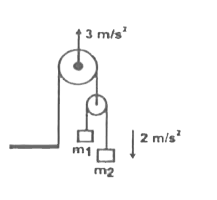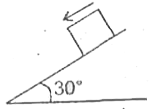Which would requires a greater force: accelerating a 2kg mass at 5m/s2 or a 4kg mass at 2m/s2?
To determine which scenario requires a greater force, we can use Newton's second law of motion, which states that force (F) is equal to mass (m) multiplied by acceleration (a). The formula is given by:
F=m×a
Let's analyze both scenarios step by step.
Step 1: Calculate the force required for the first mass
- Given:
- Mass (m1) = 2 kg
- Acceleration (a1) = 5 m/s²
Using the formula:
F1=m1×a1
F1=2kg×5m/s2
F1=10N
Step 2: Calculate the force required for the second mass
- Given:
- Mass (m2) = 4 kg
- Acceleration (a2) = 2 m/s²
Using the formula:
F2=m2×a2
F2=4kg×2m/s2
F2=8N
Step 3: Compare the forces
Now that we have calculated both forces:
- Force required for the first mass (2 kg at 5 m/s²) is 10 N.
- Force required for the second mass (4 kg at 2 m/s²) is 8 N.
Conclusion
Since F1(10N)>F2(8N), it is clear that accelerating a 2 kg mass at 5 m/s² requires a greater force than accelerating a 4 kg mass at 2 m/s².
Final Answer
The greater force is required to accelerate the 2 kg mass at 5 m/s².
---
- Given:
- Mass (m1) = 2 kg
- Acceleration (a1) = 5 m/s²
F1=m1×a1
F1=2kg×5m/s2
F1=10N
- Given:
- Mass (m2) = 4 kg
- Acceleration (a2) = 2 m/s²
F2=m2×a2
F2=4kg×2m/s2
F2=8N
Now that we have calculated both forces:
- Force required for the first mass (2 kg at 5 m/s²) is 10 N.
- Force required for the second mass (4 kg at 2 m/s²) is 8 N.
Since F1(10N)>F2(8N), it is clear that accelerating a 2 kg mass at 5 m/s² requires a greater force than accelerating a 4 kg mass at 2 m/s².
The greater force is required to accelerate the 2 kg mass at 5 m/s².
Topper's Solved these Questions
Similar Questions
How much force is required to produce an acceleration of 2ms−2 in a body of mass 0.8 kg ?
View SolutionIn the figure shown coefficient of friction between 8 kg block and surface is zero and coefficient of friction ( both static and kinetic ) between the blocks is 0.4. A force of 20 N is applied on 8 kg block as shown . The acceleration of 4 kg mass is [ g = 10m/s2]
A. 4m/s2
B. 0.5m/s2
C. 53m/s2
D. 35m/s2
View SolutionA constant force of 5 N can produce an acceleration of 1 m/s2 on the body of mass m1 and 2m/s2 on the body of mass m2 . If both the masses are tied together and same force is applied then what will be the acceleration of the system ?
View SolutionDerive the unit of force using the second law of motion. A force of 5N produces an acceleration of 8ms−2 on a mass m1 and an acceleration of 24ms−2 on a mass m2. What acceleration would the same force provide if both the masses are tied together?
View SolutionA force of 5N gives a mass m1, an acceleration of 10m/s2, and a mass m2, an acceleration of 20m/s2. What acceleration would it give if both the masses were tied together?
View SolutionTwo particles of masses 2kg and 4kg are approaching towards each other with ccelerations 1m/s2 and 2m/s2, respectively, on a smooth horizontal suface. Then find the acceleration of centre of mass of the system and direction of acceleration of CM.
View SolutionIn the figure shown, the acceleration of block of mass m2 is 2m/s2. The acceleration of m1 :

View SolutionHow much force is required to cause an object of mass 2 kg to have an acceleration of 4m/s2 ?
View SolutionThe frictional force of the air on the body of mass 0.25kg, falling with an acceleration of 9.2 m/s2 will be (g=9.8m/s2).
View SolutionA block of mass 10 kg is released on rough incline plane. Block start descending with acceleration 2m/s2. Kinetic friction force acting on block is (take g=10m/s2)

View Solution
